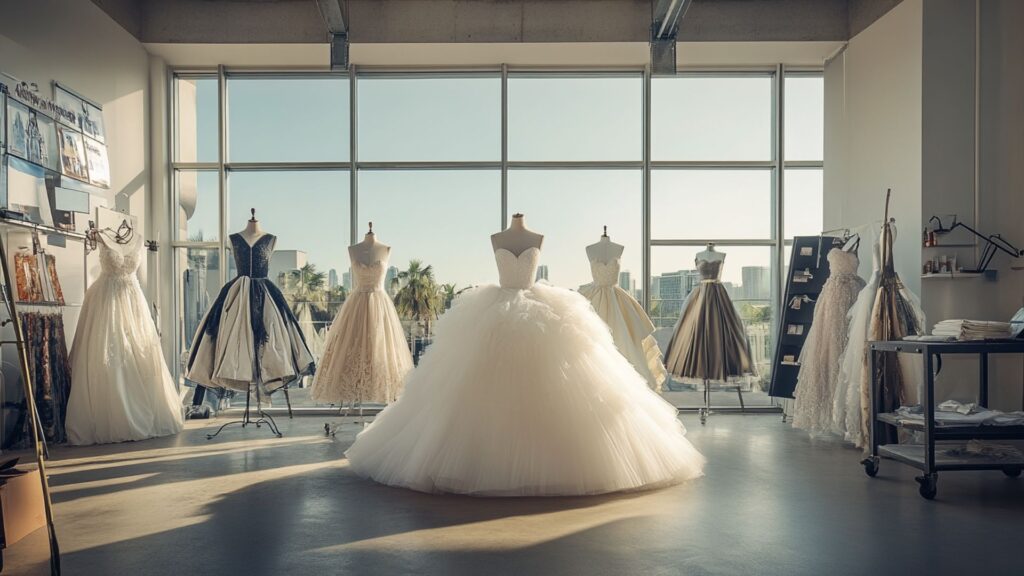
You’ve surely heard the term “designer dress” or “haute couture gown” before. Let’s explore the meaning of the designer dress and what sets it apart from mass-market clothing.
Fashion designers create a designer dress according to their original patterns and unique designs. These pieces are crafted with exceptional attention to detail and will undoubtedly become the centerpiece of your wardrobe. They differ significantly in price compared to mass-market products, but this reflects their superior quality and craftsmanship.
Designer dresses are meticulously crafted from premium materials that mass-market fashion cannot match. So what is a dress “designer”? It’s a wearable masterpiece that blends artistic heritage with contemporary style.
Understanding the essence of designer fashion reveals a world where clothing becomes a timeless art form. Let’s explore these nuances together and discover what makes designer dresses so special.
What Defines a True Designer Dress?
A designer dress is a perfect blend of artistry and creative vision. These features elevate it far above ordinary garments found in typical retail stores. A well-crafted designer dress embodies the originality and distinctive aesthetic of its creator, representing their unique creative vision.
Each piece tells a unique story through its carefully crafted design process. What makes a dress truly “designer”? Here are the core elements that set designer pieces apart:
- Originality. A designer dress is one-of-a-kind, reflecting fresh ideas while avoiding generic trends. Designers push creative boundaries with innovative cuts, silhouettes, and unexpected pattern combinations that you won’t find anywhere else.
- Signature Design Aesthetic. Each designer has a distinct style that becomes their trademark. Think of Chanel’s timeless elegance or Alexander McQueen’s bold, dramatic flair. This aesthetic signature shines through in every stitch and design detail.
- Superior Craftsmanship. What makes a dress designer quality? The answer lies in its creation process. Designers sketch unique designs and tailor them with meticulous precision. They source premium materials, such as silk or handwoven textiles, which contrasts sharply with mass production’s automated and cost-driven methods.
- Creative Vision. A designer dress carries the creator’s story, inspiration, or artistic message. It’s wearable art, not just clothing. These pieces often reflect cultural narratives, personal experiences, or innovative design concepts.
- Exclusivity. Designer dresses are often limited-edition or custom-made pieces. This rarity adds both value and prestige, making each dress more unique and sought after.
Materials & Craftsmanship: The Hidden Luxury
What is the difference between a designer dress vs a regular dress? Designer dresses showcase premium materials and meticulous artistry that elevate them to the status of masterpieces. These pieces demonstrate the perfect marriage of luxury fabrics and skilled human craftsmanship.
What materials do designer dresses use? Think sumptuous silk, cashmere blends, and intricate hand embroidery. These choices, combined with expert tailoring, create the hidden luxury that defines designer fashion.
- Premium Fabrics. Designers source the highest quality materials available. They choose silk for its fluid drape, organic cotton for sustainability, and cashmere blends for unmatched softness. These fabrics feel luxurious and maintain their beauty much longer than synthetic alternatives.
- Hand Embroidery. Many designer dresses feature intricate hand-stitched embroidery and beadwork. This artisanal craftsmanship adds unique detailing that’s completely unlike machine-made patterns found in mass-market clothing.
- Small-Batch Production. Designer dresses are crafted in limited quantities, ensuring exclusivity while enabling meticulous quality control throughout the production process.
- Attention to Detail. What defines a designer dress as exceptional quality is the focus on perfect stitching and precise cuts. Every seam is flawless, and every cut enhances both comfort and elegance.
- Human Touch in Tailoring. Skilled artisans tailor each dress with precision and care, ensuring a unique and personalized fit. This human craftsmanship creates perfect fits that automated factory production cannot achieve.
These elements combine to make designer dresses truly special. The combination of rare materials, small-batch production, and meticulous artistry creates garments that blend art with luxury. Investing in designer fashion means owning pieces crafted with uncompromising attention to detail.
How to Identify a Real Designer Dress

With counterfeits flooding the market, knowing how to identify authentic designer dresses is crucial for protecting your investment. Authentic designer pieces showcase superior craftsmanship and quality that fakes cannot replicate. Here are key strategies to spot genuine designer dresses:
- Check Labels & Branding Details. Genuine designer dresses feature high-quality labels with clear, precise logos that are neatly stitched. Counterfeit labels often contain misspellings, uneven stitching, or poor-quality materials that give them away immediately.
- Feel the Fabric Quality. Designer dresses are crafted from premium materials that feel distinctly luxurious and have a substantial weight. Authentic fabrics have a quality that’s unmistakable compared to the cheap synthetics typically used in counterfeit pieces.
- Inspect Construction Quality. Examine zippers, hems, and seam work carefully. Real designer dresses feature flawless stitching, sturdy hardware, and perfectly even hems. Counterfeits often show loose threads, crooked seams, or sloppy finishing work.
- Buy from Trusted Sources. Purchase from reputable retailers, authorized dealers, or directly from designer boutiques. Avoid unverified online sellers offering steep discounts that seem too good to be true.
- Look for Authentication Documents. Many designers provide certificates of authenticity or serial numbers with their pieces. Always verify these credentials through the brand’s official channels before making significant purchases.
Why Invest in Designer Dresses?
Why invest in designer dresses? Designer dresses represent much more than just clothing – they’re wearable art and lasting investments. What makes designer fashion unique is its perfect blend of artistry, heritage, and exceptional quality. These pieces offer superior durability and emotional connection while serving as timeless staples in any wardrobe.
- Superior Durability. Designer dresses are crafted from premium materials like silk and cashmere, combined with expert craftsmanship that ensures they withstand regular wear while maintaining their beauty. Quality designer pieces outlast fast fashion by decades.
- Value Retention. Many designer dresses retain or even increase their value over time. Vintage or limited-edition pieces from houses like Chanel or Dior often become highly sought-after collectibles that appreciate significantly.
- Timeless Style. Designer dresses transcend fleeting trends through innovative designs and flawless construction. Their classic appeal makes them versatile enough for any special occasion, year after year.
- Sustainability. Designer fashion often involves ethical production practices and small-batch manufacturing. Choosing quality over quantity reduces environmental waste compared to the disposable fast-fashion approach.
- Unmatched Artistry. What truly sets designer fashion apart is its unparalleled creativity and craftsmanship. Each dress represents a genuine masterpiece that reflects the designer’s vision, inspiration, and artistic heritage.
What makes designer fashion unique? Designer pieces complement any wardrobe with their rich history and enduring relevance. You can visit flagship boutiques or trusted luxury retailers to find pieces that perfectly combine tradition with innovation.

